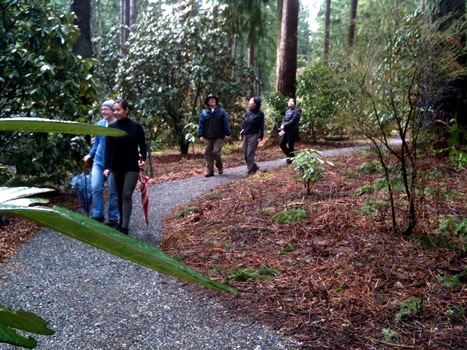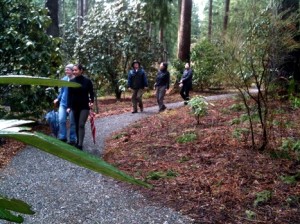After almost 15 years in the making, we are nearing completion of what will be one of the most spectacular sections of the RSBG – the Big-Leaf Garden. This is the single-largest individual display in the RSBG devoted to a single group or theme in the entire garden. With an almost complete collection of the members of subsections Falconera and Grandia (“the big-leafs”) on display beneath a grove of proportionally massive native conifers (Douglas-fir, western hemlock and western red cedar), this will be a fantastic educational and aesthetic presentation.
Each of the species is represented by numerous specimens representing collections from as many different provenances as possible. Rhododendron rex ssp. rex for example, is represented by at least 35 specimens, each a distinct seedling grown from different wild collections made in the various mountains in which it occurs throughout its natural range in SW China. In coming years, as these individual plants mature, a walk through this section of the garden will be reminiscent of a trek through the old-growth big-leaf rhododendron forests of the Sino-Himalaya, with literally hundreds of rhododendron trees towering high overhead, ferns and wildflowers carpeting the ground beneath.
Many of these rhododendrons are already 25 or more years in age and are reaching heights of 10 and 12 feet. As a bonus, this spring you can see the greatest number of different big-leaf species in flower that we have ever witnessed at the RSBG. The big-leaf blooming season is kicking off with semnoides, rothschildii, watsonii & the very rarely seen pudorosum in early March, followed by hodgsonii, galactinum, basilicum, arizelum, coriaceum, rex ssp. fictolacteum, sinofalconeri and kesangiae, and wrapping up with rex ssp. rex in early May. Many of these (individual plants) are blooming for the first time – very exciting!
In addition, a new path has just been punched through the native forest to maximize the full extent and reach of our irrigation system in the back portion of the big-leaf garden. This has added a whole new section for planting and display (with new plants going in almost weekly) that has increased the overall size of this particular section of the garden by at least one-third. In addition, new displays of the “alpine form” of macabeanum (NAPE#052 from Mt. Saramati in Nagaland) and the recently described heatheriae from the eastern Himalaya have been planted to supplement the display. Yes, I have been having a great deal of fun.
I hope to see you in the garden! If not, be sure to keep an eye on our website as we continue to improve and add to this very vital portal of communication – new images will be added weekly!
Steve Hootman


